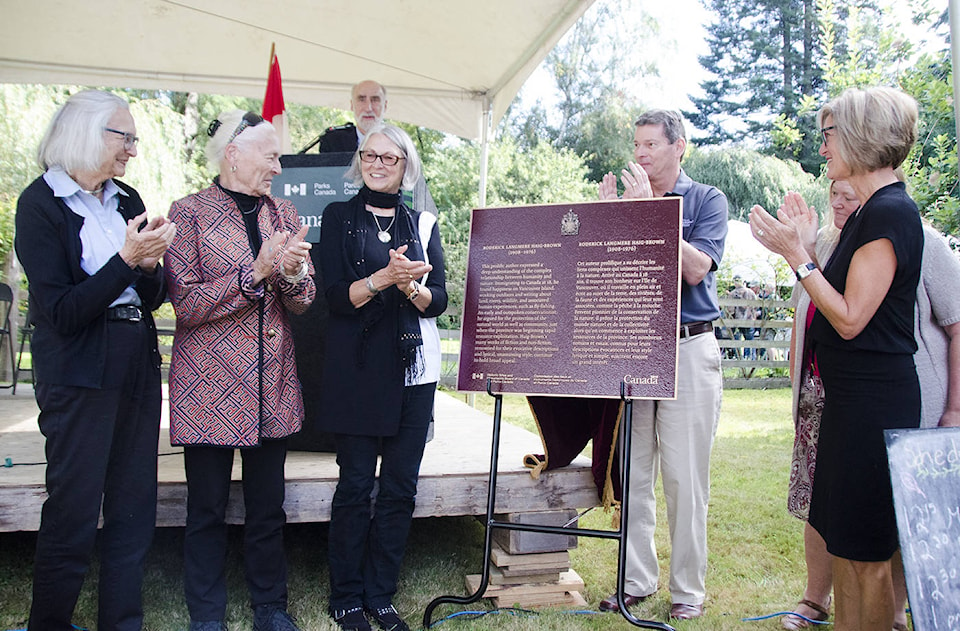What many saw as progress and prosperity in the 1950s and ’60s, Roderick Haig-Brown saw as an assault upon the land, the sea, the air and all living things.
As I would hope is evident to regular Chronicles readers by now, it pleases me to give credit where credit is due. Sometimes, alas, it must be done posthumously, which seems to be the case more and more often these days.
But I’m not the only one to arrive after the last curtain has fallen. Just last month, the National Historic Sites and Monuments Board of Canada got around to unveiling a plaque naming pioneer Campbell River author and conservationist Roderick Haig-Brown “a Person of National Historic Significance”.
RELATED: Roderick Haig-Brown named Person of National Historic Significance
This makes him one of the exalted Canadians who shares this highest of honours with the likes of Terry Fox. Haig-Brown was an outspoken champion of nature before it became fashionable; in fact, at a time when it was counter to the longest economic boom, based mostly upon resource extraction and exploitation, in provincial history. It took the NHSMB six years to review Haig-Brown’s eligibility for national recognition which was proposed by the Campbell River Museum in 2011. As quoted in the Campbell River Mirror, the museum’s executive director thought him to be a prime candidate based upon his “legacy of environmental stewardship [that] permeated his writings and made his voice a very influential one in the early conservation movement in Canada.”
MP Pamela Goldsmith-Jones, on behalf of the minister of Environment and Climate Change, cited Haig-Brown’s contribution to Canada as a fly fisher, a writer, a conservationist, a political activist, a magistrate, a husband and a father.
Perhaps his daughter Celia said it best when she spoke of him having been “a man before his time [who] understood about interrelationships — that we are one with the land rivers. Long before conservation had much currency in the eyes of industry and government, he forced attention to the issues.”
An avid fly fisherman who was lionized by Life magazine in 1965 as the most eloquent of modern-day fishing prose writers, he once explained his passion this way: “I remember the good evenings I have fished, even the ones that realised material hopes not by the fish that came to the fly, but by the colour and movement of the water and sky, by the sounds and scents and gentle stirrings that were all about me.”
Another time, he explained in a single sentence: “Perhaps fishing is, for me, only an excuse to be near rivers.”
He’d never seen a river that he couldn’t love: “Moving water…has a fascinating vitality. It has power and grace and associations. It has a thousand colours and a thousand shapes, yet it follows laws so definite that the tiniest streamlet is an exact replica of a great river.”
As a conservationist, his was a lifelong commitment: “It seems clear beyond possibility of argument that any given generation of men can have only a lease, not ownership, of the earth; and one essential term of the lease is that the earth be handed down on to the next generation with unimpaired potentialities. This is the conservationist’s concern.”
And, finally: “Man must make himself small and humble to live within it rather than a ruthless giant to conquer it.”
For all his eloquence he could be blunt, even vitriolic. He openly despised the Social Credit government of W.A.C. Bennett for its “shoddy, uncaring development of our natural resources,” and he reviled “The chamber of commerce mentality which favors short-term material gain over all other consideration, the utter contempt for human values of every kind.”
In short, what so many saw as progress and prosperity, Roderick Haig-Brown saw as war upon the land, the sea, the air and all living things.
Sussex-born in 1908, the son of a distinguished educator who was killed in the First World War, he was raised on the land by a grandfather and an uncle. He was just 16 when he took up the cause of conservation by protesting the pollution of fish-bearing streams by the run-off from road tar.
He came to Canada, aged 18, after being expelled from a leading private school and became a log scaler in Washington state.
But it was on Vancouver Island, where he’d moved work as a surveyor that the waste and destruction of the logging practices of the day hit home. Then he noticed other things such as the government’s war of extermination against cougars, sea lions and basking sharks which were considered to be ‘noxious pests’.
Initially, he accepted this as gospel. But, slowly, Haig-Brown came to realize that, for the most part, it was humans that were the problem. How was it, he asked, that the creatures of the earth had lived synergetically for millions of years but were now, as in the case of the listed predators, a threat to the natural order of things?
He became a published writer of at least 25 books, including two novels, all of them in some way dealing with nature and sustainability.
His books sold in the hundreds of thousands and his most popular title is A River Never Sleeps. His career as a champion of the environment continued until his death in 1976, aged 68.
Campbell River has Haig-Brown Heritage House and there’s Roderick Haig-Brown Provincial Park. Now, as of last month, Canada recognizes him as Person of National Historic Significance.
It takes no real imagination to guess where he’d stand today on the issue of pipelines and oil tankers.
